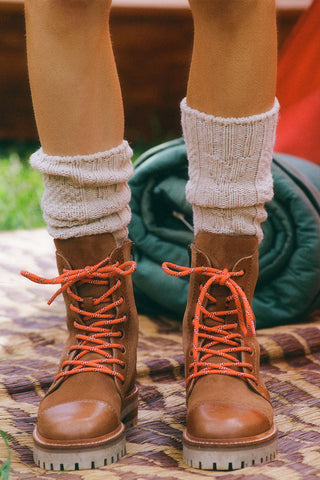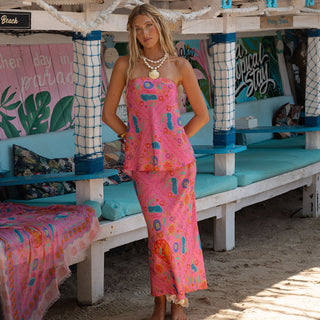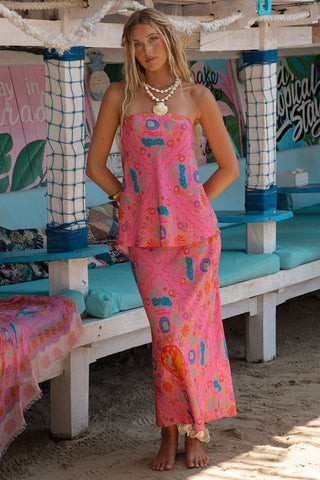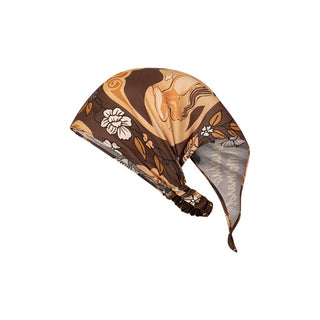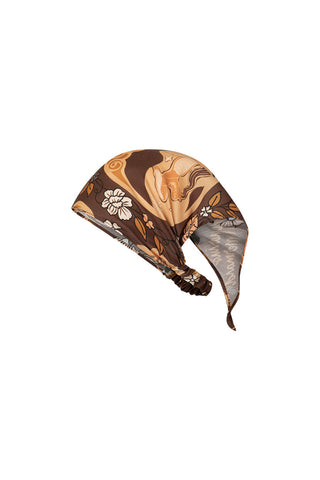All materials take from our planet, but some are more sustainable than others. In fact, the textile industry draws on an enormous amount of resources each year including water, energy, agricultural land, fossil fuels and animals; to name a few, at the raw materials stage of the process. This attributes to close to ⅔ of the sustainability impact of a piece of clothing.
We are committed to creating from the most sustainable fibres we can source whilst staying true to the premium quality, buttery-soft fabrics our customers have come to expect and love. In order to do so, we have developed a Preferred Fibres Matrix.
We define ‘Preferred Fibres’ via a wide range of material specific indicators that include land usage, water/ energy/ raw material inputs, toxicity and water/ waste/ carbon footprints. We use a variety of accredited certification schemes to ensure we are meeting the highest international standards relating to a fibres social and environmental impact.
In the aim of meeting our goal we have developed a clear preferred fibres matrix that our team works to, as per the below:
PREFERRED FIBRE MATRIX
Preferred Fibres
Preferred Fibres


| PREFERRED FIBRES | NON-PREFERRED | DO NOT USE |
||
|---|---|---|---|---|
| PREFERRED | GOOD | OK | PHASE OUT | |
| Canopy Style Standard cellulose (audited to score of 20-25) | Certified Responsible (RWS) Wool | Linen | Conventional Cellulose | Angora |
| Certified Recycled (GRS) Cotton | Certified Responsible (RDS) Down | LWG Leather | Conventional Cotton | Conventional Leather |
| Certified Recycled (GRS) Synthetic | BCI Cotton | New Merino Wool | Conventional Rayon | Exotic Animal Skin |
| Certified Organic (GOTS) Cotton | Hemp | Transitional Cotton | Conventional Silk | Mohair |
| Certified Organic (GOTS) Linen | Peace Silk | Conventional Synthetic | PVC | |
| Organic (OCS) | Conventional Wool | Fur | ||
| PREFERRED FIBRE ACRONYM KEY |
|---|
| PREFERRED FIBRES | NON-PREFERRED | DO NOT USE |
||
|---|---|---|---|---|
| PREFERRED | GOOD | OK | PHASE OUT | |
| Canopy Style Standard cellulose (audited to score of 20-25) | Certified Responsible (RWS) Wool | Linen | Conventional Cellulose | Angora |
| Certified Recycled (GRS) Cotton | Certified Responsible (RDS) Down | LWG Leather | Conventional Cotton | Conventional Leather |
| Certified Recycled (GRS) Synthetic | BCI Cotton | New Merino Wool | Conventional Rayon | Exotic Animal Skin |
| Certified Organic (GOTS) Cotton | Hemp | Transitional Cotton | Conventional Silk | Mohair |
| Certified Organic (GOTS) Linen | Peace Silk | Conventional Synthetic | PVC | |
| Organic (OCS) | Conventional Wool | Fur | ||
| PREFERRED FIBRE ACRONYM KEY |
|---|
BCI – Better Cotton Initiative RCS - Recycling Content Standard
GOTS - Global Organic Textile Standard RDS - Responsible Down Standard
GRS - Global Recycled Standard RWS - Responsible Wool Standard
LWG – Leather Working Group OCS – Organic Content Standard
BCI – Better Cotton Initiative RCS - Recycling Content Standard
GOTS - Global Organic Textile Standard RDS - Responsible Down Standard
GRS - Global Recycled Standard RWS - Responsible Wool Standard
LWG – Leather Working Group OCS – Organic Content Standard
To see how we plan to implement more sustainable fibres into our collections by 2025 view our ROADMAP. However if you would like to learn more about some of our fibres please keep on reading.
WHY WE LOVE ORGANIC COTTON
Conventional cotton is not great. In fact, it has one of the highest environmental impacts per kilogram of material. However, organic cotton is a dramatically different story with up to a quarter of the environmental impact of conventional cotton. Click on the icons to learn why it’s good for the planet and good for the farmers:
WHY WE LOVE ORGANIC COTTON
Conventional cotton is not great. In fact, it has one of the highest environmental impacts per kilogram of material. However, organic cotton is a dramatically different story with up to a quarter of the environmental impact of conventional cotton. Click on the icons to learn why it’s good for the planet and good for the farmers:
![]()
Non-Genetically Modified: Good for the planet and farmers are not unethically bound to GM multinationals.
![]()
Farmers work with nature rather than against it. Organic cotton is grown as part of a balanced ecosystem, resulting in healthy soils and strengthened biodiversity.
![]()
No nasties in the form of synthetic chemicals (fertilisers and pesticides) are allowed. A double win with no scary toxins poisoning the earth and additionally we have happy, healthier farmers.
![]()
With only a quarter of the environmental impact, the planet is loving organic. Organic has a 60% reduction in Greenhouse Gas emissions, so doing its part to fight climate change.
![]()
The highest international social and environmental criteria are met during the processing and manufacturing stages. No hazardous chemicals are used and all waste water needs to be treated. Great for people and the planet.

FOR THE LOVE OF EARTH:
We are committed to using organic cotton over conventional cotton wherever possible in our collections. Our preference is to have all cotton certified to the Global Organic Textile Standard (GOTS). This provides us with assurance that every single cotton fibre used in the garments is certified organic. Additionally, it has a strict set of protocols focusing on the environmental, social and ethical impacts related to manufacturing. To date, all the cotton in our SATLG collection is 100% GOTS organic certified. By the end of 2019, we are aiming for at least 70% of our cotton to be organic across our entire production.

FOR THE LOVE OF EARTH:
We are committed to using organic cotton over conventional cotton wherever possible in our collections. Our preference is to have all cotton certified to the Global Organic Textile Standard (GOTS). This provides us with assurance that every single cotton fibre used in the garments is certified organic. Additionally, it has a strict set of protocols focusing on the environmental, social and ethical impacts related to manufacturing. To date, all the cotton in our SATLG collection is 100% GOTS organic certified. By the end of 2019, we are aiming for at least 70% of our cotton to be organic across our entire production.
WHY WE LOVE RECYCLING
Recycling and reusing may not sound exciting, but trust us it is! Whilst being a simple idea, it is one of the most effective sustainability initiatives, particularly in the instance of man-made synthetic fibres. Nylon, polyester and the rest of the synthetic family are no sustainability heroes. They are, in fact, made with non-renewable fossil fuels, produce heaps of greenhouse gases and then to top it off take around 200 years to decompose. But if we recycle existing synthetic fibre we can become part of the solution. Did you know that recycled nylon and polyester are actually made of old fabric, plastic bottles and abandoned fishing nets? Explore the icons to learn why we love recycled:
WHY WE LOVE RECYCLING
Recycling and reusing may not sound exciting, but trust us it is! Whilst being a simple idea, it is one of the most effective sustainability initiatives, particularly in the instance of man-made synthetic fibres. Nylon, polyester and the rest of the synthetic family are no sustainability heroes. They are, in fact, made with non-renewable fossil fuels, produce heaps of greenhouse gases and then to top it off take around 200 years to decompose. But if we recycle existing synthetic fibre we can become part of the solution. Did you know that recycled nylon and polyester are actually made of old fabric, plastic bottles and abandoned fishing nets? Explore the icons to learn why we love recycled:
![]()
Conserves non-renewable resources. By not using fossil fuels to make fibres, the environment and communities are already happier.
![]()
Recovering abandoned fishing nets to make fabric saves our precious ocean ecosystems.
![]()
Recycled fibres have up to 75% lower environmental footprints than its virgin synthetic alternative! This means that we reduce carbon emissions and save precious water.
![]()
Our favorite…most modern recycled fibers are regenerative and this means that they can be recycled over and over again, so it never goes to landfill!

BECOMING PART OF THE SOLUTION:
We are using ECONYL®, an innovative Italian fabric made from 78% recycled nylon for the majority of our swim range, so you can enjoy knowing that rather than wearing swim made from virgin materials you’re actually part of the solution! As of May 2019, we've also transitioned our signature Spell intimates to recycled.

BECOMING PART OF THE SOLUTION:
We are using ECONYL®, an innovative Italian fabric made from 78% recycled nylon for the majority of our swim range, so you can enjoy knowing that rather than wearing swim made from virgin materials you’re actually part of the solution! As of May 2019, we've also transitioned our signature Spell intimates to recycled.
WHY WE LOVE CELLULOSE FIBRES
Did you know a number of our garments start their life as a tree? Technically known as cellulose fibres, our forest fabrics include viscose, rayon, tencel and modal, and are derived from wood pulp. The beauty of this raw material is that wood pulp is a 100% renewable resource, which means forest fabrics can have a place in the sustainability story when sourced from sustainably managed forests and when produced in an eco-responsible way ensuring a low environmental impact. However, when cellulose fibre is produced from uncertified sources it may result in harmful deforestation and the conventional production processes can be chemical heavy.
Explore the icons to learn why we love eco-responsible forest fabrics:
WHY WE LOVE CELLULOSE FIBRES
Did you know a number of our garments start their life as a tree? Technically known as cellulose fibres, our forest fabrics include viscose, rayon, tencel and modal, and are derived from wood pulp. The beauty of this raw material is that wood pulp is a 100% renewable resource, which means forest fabrics can have a place in the sustainability story when sourced from sustainably managed forests and when produced in an eco-responsible way ensuring a low environmental impact. However, when cellulose fibre is produced from uncertified sources it may result in harmful deforestation and the conventional production processes can be chemical heavy.
Explore the icons to learn why we love eco-responsible forest fabrics:
![]()
LENZING™ ECOVERO™ and LENZING™ Modal fibres derive from certified renewable wood sources and use an eco-responsible production process that meets high environmental standards, tailoring to a sustainable lifestyle and contributing to a cleaner environment.
![]()
LENZING™ ECOVERO™ branded Viscose fibres are certified with the internationally recognised EU Ecolabel. This label of environmental excellence is only awarded to products and services which have a significantly lower environmental impact throughout their lifecycle: from raw material extraction to production, distribution and disposal. This fibre generates up to 50% lower emissions and water impact compared to generic viscose. Numerous LENZING™ innovations have been integrated in the production of LENZING™ Modal fibres, to make the process environmentally sound.
![]()
Derived from nature, LENZING™ products have been certified as biodegradable and compostable under industrial, home, soil and marine conditions. At the end of their life cycle, the fibres can re-enter the eco-system thus nature returns to nature.
![]()
Fibres are made from natural wood that grows without the need for irrigation. The manufacturing of LENZING™ ECOVERO™ fibres generates up to 50% lower water impact compared to generic viscose.

BECAUSE WE LOVE FORESTS:
For a long time we’ve been using conventionally produced rayon and viscose, so it’s been a very important part of our sustainability journey to seek a better source of this fibre. In 2018 we became a signatory to the Canopy Policy with the aim to advance the conservation of ancient or endangered forests globally through responsible sourcing of cellulose fibres.
In a huge win we are now working with LENZING™ who use wood and pulp derived from responsibly managed forests and certified to come from sustainable sources. Furthermore, LENZING™ strives to safeguard resources for future generations by the use of renewable energy and by the recovery of process chemicals. Their manufacturing uses lower emissions and water than generic alternatives.
Our aim is to only use certified eco-responsible cellulose fibres by 2025, look for the LENZING™ ECOVERO™ and LENZING™ Modal tags across our collections.

BECAUSE WE LOVE FORESTS:
For a long time we’ve been using conventionally produced rayon and viscose, so it’s been a very important part of our sustainability journey to seek a better source of this fibre. In 2018 we became a signatory to the Canopy Policy with the aim to advance the conservation of ancient or endangered forests globally through responsible sourcing of cellulose fibres.
In a huge win we are now working with LENZING™ who use wood and pulp derived from responsibly managed forests and certified to come from sustainable sources. Furthermore, LENZING™ strives to safeguard resources for future generations by the use of renewable energy and by the recovery of process chemicals. Their manufacturing uses lower emissions and water rather than generic alternatives.
Our aim is to only use certified eco-responsible cellulose fibres by 2025, look for the LENZING™ ECOVERO™ and LENZING™ Modal tags across our collections.

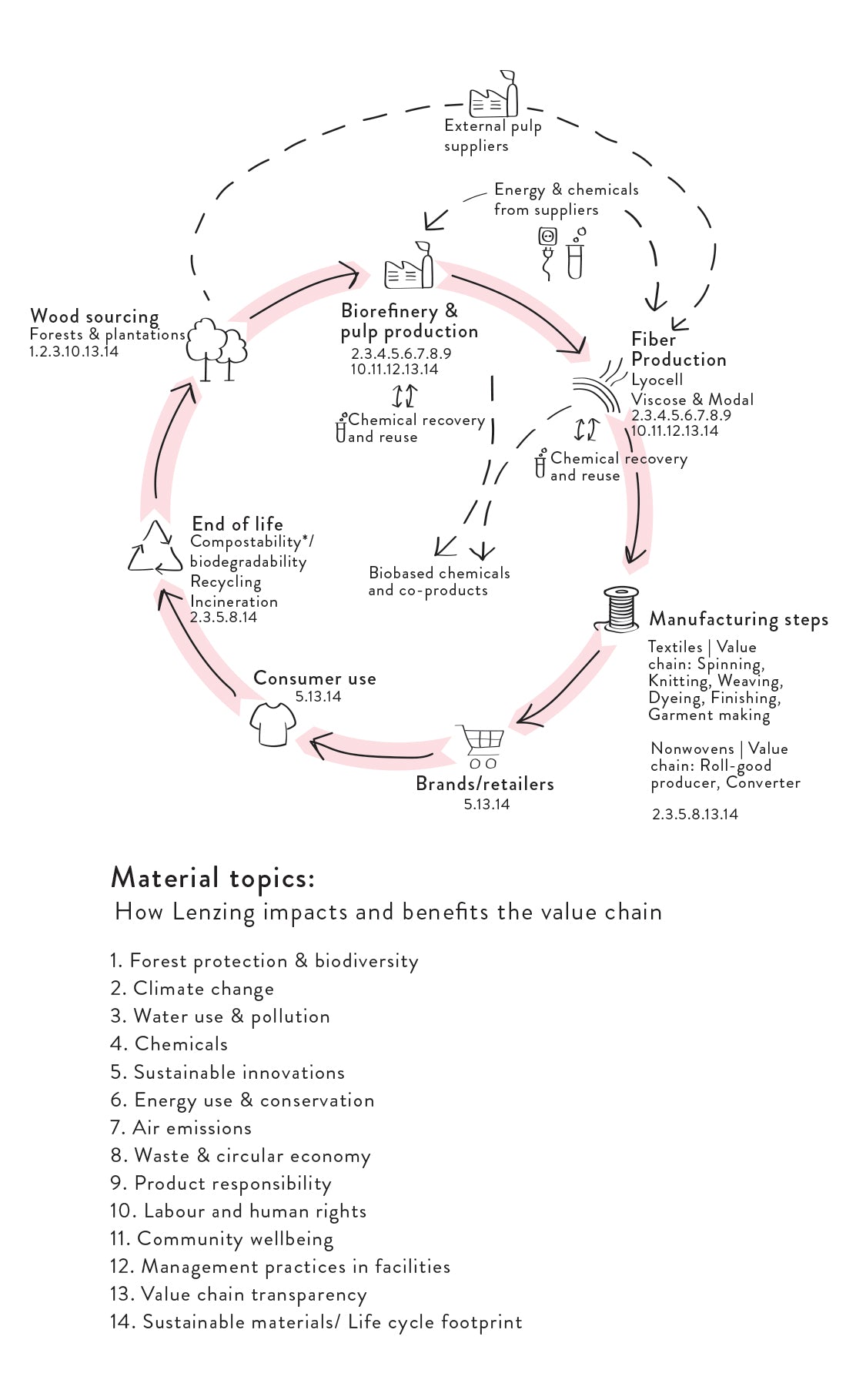
WHY WE LOVE HEMP
One of the oldest and most resilient fibres, hemp has had somewhat of a renaissance of late, and when you look at its glowing sustainability attributes, you can understand why:
WHY WE LOVE HEMP
One of the oldest and most resilient fibres, hemp has had somewhat of a renaissance of late, and when you look at its glowing sustainability attributes, you can understand why:
![]()
One of the strongest natural fibers (six times as strong as cotton), robust, versatile, durable and breathable.
![]()
One of the most resilient plants that requires no insecticides, herbicides or irrigation. It’s a fast grower (4m in 3 months) and perfect for crop rotation. It suppresses weeds and its deep rooting system is excellent for soil structure and biodiversity.
![]()
A natural fibre meaning it is biodegradable.

BYRON BAY'S GOLDEN FIBRE
All hippy hemp clichés aside, we love this fibre and are proud to be using it from our Spring 2019 collection onwards. Even conventionally grown Hemp is still considered to be an environmentally friendly option, but as hemp is being more widely embraced globally, the supply of organic hemp options (currently minimal) are becoming more widely available. And of course we will be doing everything we can to source.

BYRON BAY'S GOLDEN FIBRE
All hippy hemp clichés aside, we love this fibre and are proud to be using it from our Spring 2019 collection onwards. Even conventionally grown Hemp is still considered to be an environmentally friendly option, but as hemp is being more widely embraced globally, the supply of organic hemp options (currently minimal) are becoming more widely available. And of course we will be doing everything we can to source.
WHY WE LOVE LINEN
We love linen for so many reasons! From its amazing quality characteristics to its versatility to it’s sustainability benefits we are keen to continue this love affair. Click on the icons to learn more.
WHY WE LOVE LINEN
We love linen for so many reasons! From its amazing quality characteristics to its versatility to it’s sustainability benefits we are keen to continue this love affair. Click on the icons to learn more.
![]()
Linen is uniquely strong, versatile, able to withstand high temperatures and actually improves with age.
![]()
Did you know linen is made from flax plants? The beauty of this plant is it’s resilience. It can be grown in poor soils and doesn’t require much water. So, in contrast to cotton, it requires far less inputs and has a smaller environmental footprint. Additionally the whole flax plant is typically used so there is no waste at all!
![]()
Linen is a naturally biodegradable fibre. Additionally, linen fibre can easily be recycled and regenerated.

IT’S ALL ABOUT LINEN:
We are designing with linen to achieve gorgeous, soft textures in a wonderfully sustainable fibre. Even with linen’s unique quality and sustainability attributes, much of the world's linen production is still grown using conventional farming methods. In the future we will begin to explore organic linen options wherever possible to ensure minimal social and environmental impact.

IT’S ALL ABOUT LINEN:
We are designing with linen to achieve gorgeous, soft textures in a wonderfully sustainable fibre. Even with linen’s unique quality and sustainability attributes, much of the world's linen production is still grown using conventional farming methods. In the future we will begin to explore organic linen options wherever possible to ensure minimal social and environmental impact.

WHY WE LOVE LEATHER
The leather industry is a divisive topic in the fashion industry with factors such a deforestation, animal welfare and chemical processing all coming into play, but there are still a number of reasons why we love leather. Click on the icons below to learn more.
WHY WE LOVE LEATHER
The leather industry is a divisive topic in the fashion industry with factors such a deforestation, animal welfare and chemical processing all coming into play, but there are still a number of reasons why we love leather. Click on the icons below to learn more.
![]()
Leather boasts unique qualities of diversity, flexibility and durability.
![]()
Leather has been embraced and celebrated by artisans for generations. Our founders’ father was a leather craftsman in the 1960s so leather is a material that has always been close to our hearts.
![]()
A sustainable piece is one that has the ability to last generations. It is the antithesis of fast fashion and doesn’t end up in landfill. It can literally last a lifetime and be passed down from mother to daughter.

BACK TO OUR ROOTS:
Spell sources the most ethical and environmentally friendly leather possible. Our leather is sourced from approved Leather Working Group Tanneries, a group of industry leaders in an array of fields that have developed an environmental stewardship protocol for the leather manufacturing industry. The protocol covers topical issues within the leather supply chain such as deforestation, traceability, water and energy consumption, solid and liquid waste management, noise and air pollution as well as restricted chemicals and environmental best practice. We are also committed to putting resources into being able to have complete traceable supply chain for our leather products to ensure we are not supporting deforestation and inhumane farming practices.
BACK TO OUR ROOTS:
Spell sources the most ethical and environmentally friendly leather possible. Our leather is sourced from approved Leather Working Group Tanneries, a group of industry leaders in an array of fields that have developed an environmental stewardship protocol for the leather manufacturing industry. The protocol covers topical issues within the leather supply chain such as deforestation, traceability, water and energy consumption, solid and liquid waste management, noise and air pollution as well as restricted chemicals and environmental best practice. We are also committed to putting resources into being able to have complete traceable supply chain for our leather products to ensure we are not supporting deforestation and inhumane farming practices.

What About Vegan Leather?
Additionally our R&D team is continually trialing sustainable vegan leather opportunities (made from mushrooms or pineapple leaves for instance) to find a suitable alternative that has no animal welfare and environmental issues whilst still having the ability to last generations.
WHY WE LOVE SILK
We love silk for its elegant lustre and soft handfeel! It is a natural fibre so it’s biodegradable and it’s also one of the most hypoallergenic fabrics. Explore the icons to learn why we love this fabric:
WHY WE LOVE SILK
We love silk for its elegant lustre and soft handfeel! It is a natural fibre so it’s biodegradable and it’s also one of the most hypoallergenic fabrics. Explore the icons to learn why we love this fabric:
![]()
Silkworms feed on cultivated mulberry trees. Mulberry trees are usually planted on land that is unsuitable for cropping and their unique deep root structure plays an important role in reducing soil loss and erosion. Additionally, they require few chemical inputs and use less water than cotton.
![]()
The boiled pupae of silkworms are an incredibly important protein source in SE Asia. In contrast to livestock, insects have an amazingly low carbon footprint, and viewed as an environmentally friendly option.
![]()
All our silk is dyed using environmentally friendly acid dyes. Acid dyes are environmentally low impact as all the dye is taken up by the fabric, resulting in very little waste.
![]()
Silk is a natural fibre and as such is biodegradable, therefore not contributing to pollution or landfill.

SILK = VINTAGE:
Low impact agriculture, environmentally friendly dyes and a biodegradable product are certainly in line with our vision, however with silk there are inherent animal welfare issues to consider. Our R&D team have explored a number of different options. Alternatives such as Peace silk exist, however, have been found to have quality issues with yarns breaking more easily as the silk strand is broken when the moth emerges from the cocoon. We are currently researching innovative developments in vegan silk, although many are still in the very early stages. We hope to have more information here soon.

SILK = VINTAGE:
Low impact agriculture, environmentally friendly dyes and a biodegradable product are certainly in line with our vision, however with silk there are inherent animal welfare issues to consider. Our R&D team have explored a number of different options. Alternatives such as Peace silk exist, however, have been found to have quality issues with yarns breaking more easily as the silk strand is broken when the moth emerges from the cocoon. We are currently researching innovative developments in vegan silk, although many are still in the very early stages. We hope to have more information here soon.














